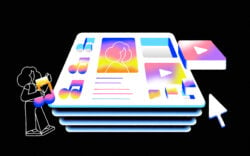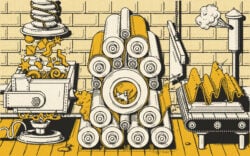Illustration: Angie Zou
You’ve just finished a brand new track and you’re ready to share it with the world.
This means you’re ready to dive into the exciting world of music distribution.
So what’s the best way to approach this? Well, you can upload your song to SoundCloud or YouTube. If you have an entire album, you can even sell it on Bandcamp.
While these options are great and you should absolutely consider uploading your music to these places, doing that alone probably won’t give your music the reach you’re hoping for. That’s because a huge population of listeners use streaming platforms like Spotify, Apple Music, Tidal, Amazon Music, and the like.
So how do you get your music onto these platforms? For that, you need a music distributor.
Keep reading to find out everything you need to know about music distribution—what it is, the benefits of using a distributor, the different types, and what to consider when choosing a music distribution service. We’ll also talk about a few of the most popular music distributors to help you figure out your next steps.
Feel free to use the table of contexts below to quickly navigate to a specific section.
What you’ll learn:
- What is music distribution?
- Why you should use a music distributor
- Types of music distributors
- What to consider when choosing a distributor
- Popular music distribution services to consider
- Which music distribution service is the best?
Feeling ready? Let’s get your music out there!
What is music distribution?
Music distribution is the process of getting music to the consumer. Back in the day, this used to mean pressing records and getting them into stores. Today, distribution mainly refers to uploading music to digital service providers (DSPs) so that listeners can stream or download it.
While physical distribution still exists, most artists are primarily concerned with getting their music onto streaming platforms. Not only is it cheaper, but this is also where their songs have the best chance of getting heard across the world. For this reason, this article will focus specifically on digital distribution.
Why you should use a music distributor
There are a few benefits to making use of a music distributor—we explore some of the most prominent ones below.
1. Get your music onto streaming platforms
The biggest and most obvious reason to work with a distributor is that they will help you get your music to DSPs. There’s simply no other way to get your songs onto Spotify, Apple Music, or other streaming platforms.
Imagine what would happen if Spotify, for example, allowed people to upload their music on their own—the platform would likely become a tangled mess of unstandardized metadata, duplicate records, and missing information. A distributor, on the other hand, makes sure that all data is clean, complete, and follows the same format.
We’re actually quite lucky that we don’t have to upload music to streaming platforms on our own. There are hundreds of DSPs out there, and if you had to do it all by yourself, you would not only find the process extremely tedious, but also likely miss platforms you don’t know about. For example, if you didn’t know that the most popular streaming service in China is currently NetEase, you would have lost the opportunity to gain a following there.
Music distributors make sure your music gets sent to every streaming platform in the world. They will also make sure your music is available on platforms like TikTok, Instagram, and even Peloton!
2. Collect royalties
Music distributors collect royalties from DSPs and make them accessible to you all in one place. This means that you don’t have to receive a million different checks from each of the platforms where your music is played. It also means that DSPs don’t have to worry about sending checks to artists directly. It’s a win-win for both parties.
3. Expand your reach
The higher the number of platforms where your music is available, the better your chances of getting it heard. Not to mention, most DSPs have an algorithm that will recommend your music to potential new fans. In other words, when you use a music distributor, you don’t just make your song accessible to your current fans—you also create opportunities to gain brand new ones.
We’ll talk more about this in the next section, but some music distribution services can help you expand your reach even further. This is because they go beyond simply sending your music to DSPs—they help you promote it, pitch it to playlists, or maybe even get it in front of the streaming platform’s editorial team.
Types of music distributors
Now that we’ve gone over the benefits of music distribution, let’s discuss a few of the different ways you can go about it.
1. Major distributors
Major labels don’t use a music distribution service—they have their own distribution departments and a robust relationship with each of the major DSPs. They not only send their artists’ music to Spotify, but also make sure it lands on the platform’s home page and gets added to popular editorial playlists.
2. Distribution partners
Distribution companies in this category take on some of the responsibilities of a label and help develop independent artists. In return, they usually take a percentage of the artist’s royalties.
Like labels, distribution partners invest in promising artists in hopes of making a profit, so they typically only work with artists who have a proven track record and are gaining momentum. As an independent artist, you have to apply or be invited to work with a distribution partner.
Some distribution partners are owned by major labels, so distributing with them and showing rapid career growth can sometimes help artists get the attention of the parent label.
A few popular distribution partners operating today are:
- The Orchard (owned by Sony Music Entertainment)
- AWAL (owned by Sony Music Entertainment)
- Amuse
- Spinnup (owned by Universal Music Group)
- Stem
- Symphonic Distribution
- Ditto
3. Open distributors
Independent artists who are just starting out or aren’t yet ready to work with a distribution partner can release their music with an open distributor. You’ve likely already heard of companies like CD Baby, DistroKid, or TuneCore. Just about anyone can create an account with them and start distributing their music.
Most open distributors focus solely on getting your music to DSPs. They do this for an annual fee, a flat fee per release, a percentage of royalties, or some combination of these.
A few open distributors have started to move into the distribution partner territory by providing additional artist services like marketing and playlist pitching. For example, CD Baby has recently launched their label services platform called Stages. The basic tier is available to all artists, while higher tiers require an application.
Amuse and Ditto are two other companies that are bridging the gap between offering open distribution and label-like artist services. They both have an open distribution platform that anyone can use, as well as a gated tier for artists who are further along in their careers. The open platform acts as a discovery tool and helps them identify artists that are worth investing in.
What to consider when choosing a distributor
If you’re looking for an open distribution platform, there are dozens of them out there. When making your selection, be sure to take the following factors into account.
Cost and pricing structure
Some platforms charge a flat fee per single or album, while others offer their service on a subscription basis. Think about how many songs you plan to release per year—does it make more sense to pay an annual fee and release an unlimited number of songs, or pay separately for each release? Subscriptions often end up being more economical, but you may need to keep paying the annual fee for as long as you want to keep your music on DSPs.
Don’t forget to consider whether the platform takes any commission. For example, 10% of your royalties may not seem like much when you’re first starting out, but if you’re making $50,000 from streaming, that’s a sizable amount.
DSPs they distribute to
There’s no standardized list of DSPs that all distributors work with. Some will send your music to only the most popular outlets, while others will cover far more bases. If you’re hoping to gain an international following, make sure the distributor you choose works with popular outlets beyond your country. Lastly, make sure your music will get onto TikTok and Instagram, where your fans will be able to use it as background music in their own content.
Payment schedule
Your royalty payments may be available weekly, monthly, quarterly, or as soon as they reach a certain threshold. Make sure you’re comfortable with your preferred distributor’s payment schedule.
Content monetization
You’ll get royalties when someone streams your music, but what about when they use it in a YouTube video, TikTok, or Instagram reel? Make sure your distributor has a way to keep track of this content and get your royalties and ad revenue.
Publishing services
If you write your own music, you’ll likely want to look into collecting publishing royalties. You can do this on your own by signing up with a performing rights organization and registering your songs. If you want to keep all of your royalties in one place, a great option is to look for a distributor that will do this for you.
Customer support
Before committing to a distributor, do a bit of research and see what other people have to say about their customer support line. Ideally, you want to work with representatives who respond quickly and work diligently to address your concerns and resolve any issues.
Popular music distribution services to consider
While not an exhaustive list by any means, here are five popular open distributors used by emerging artists. There are plenty of other great options, but if you haven’t done your own research yet, these are a solid place to start. Prices and features listed are as of June, 2022.
CD Baby
Pricing:
- Standard: $9.95/single or $29/album
- Pro: $29.95/single or $69/album
- $5/single or $20/album for UPC code
- 9% commission
Some pros:
- They’ve been around since 1998 and have a good reputation
- CD Baby Pro includes publishing royalties collection
- Your music will be added to their sync licensing catalog
Some things to be aware of:
- 9% of royalties can add up to quite a bit depending on your situation
DistroKid
Pricing:
- $19.99/year for unlimited releases (for one artist or band)
- Musician Plus and Label plans are available to be able to distribute for additional artist and bands at a discount
Some pros:
- No commission, so you keep 100% of your royalties
- Automatically split payments with collaborators
- You can choose the snippet that gets delivered to TikTok
Some things to be aware of:
- There are additional fees for certain features (ex: YouTube monetization)
- You have to either keep paying the annual fee or pay a one-time “Leave a Legacy” fee to keep your music on DSPs
TuneCore
Pricing:
- $9.99/year for each single or $49.99/year for each album ($29.99 for the first year)
Some pros:
- No commission
- Qualifying artists can get an advance to help finance their projects
- Robust analytics and reporting
- Built-in publishing services
Some things to be aware of:
- Their annual fees are on the higher end
- There’s a 20% commission for fees and royalties related to synchronization (including Instagram and TikTok)
- You have to keep paying the annual fee to keep your music on DSPs
Amuse
Pricing:
- Free basic distribution to 13 DSPs for up to 12 releases/year
- Paid plans start at $24.99/year for unlimited releases, more DSPs, and more features
Some pros:
- No commission
- Qualifying artists can get an advance to help finance their projects
- Promising artists get approached for a label-like distribution deal
Some things to be aware of:
- Their free plan is very limited
- If you release with a Boost or Pro plan but then stop paying the annual fee, your music will be taken down from all DSPs other than the ones available on the free plan
LANDR
Pricing:
- Option 1: one-time fee of $9/single or $29/album, with 15% commission
- Option 2: $20/year and one-time fee of $5/single or $19/album, with 9% commission
- Option 3: $89/year with unlimited releases and 0% commission (this option also comes as part of their All Access Pass, which costs $14.99/month or $149.99/year and includes LANDR’s other services)
Some pros:
- Flexible pricing options
- If you stop paying the annual fee, your songs won’t be taken down from DSPs (but you’ll need to start paying a 15% commission)
Some things to be aware of:
- Distribution isn’t LANDR’s current main focus (it’s AI-powered mastering)
Which music distribution service is the best?
When it comes to choosing a distributor for your music, there’s no clear winner or a one-fits-all solution. The best option for you will depend on many factors, including how often you release music, how much revenue you expect to make through royalties, and how comfortable you are with paying annual fees or commissions.
The good news is, once you’ve chosen a distributor, there’s no rule that says you need to stay with them for the rest of your music career. You can always switch distributors when preparing your next release or even transfer your old releases from one distributor to another. As you grow and move through different stages of your career, your needs and preferences will likely change, so having to switch distributors is entirely normal, if not expected.
The best thing you can do for now is do your research and choose the option that makes the most sense for you at this moment. You can always re-evaluate later. Besides, music distribution companies and the services they offer are constantly evolving, so you never know what the digital distribution landscape might look like in a few years.
Explore royalty-free sounds from leading artists, producers, and sound designers:
June 8, 2022

.svg)
.svg)




